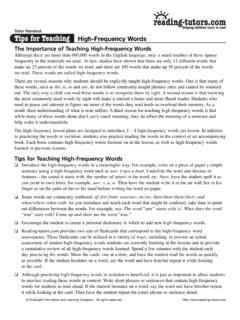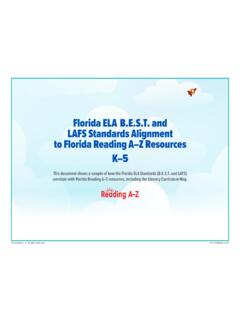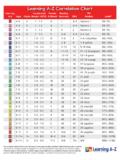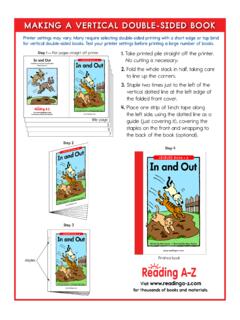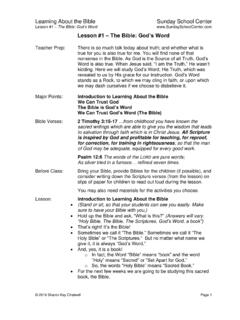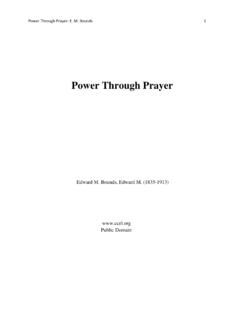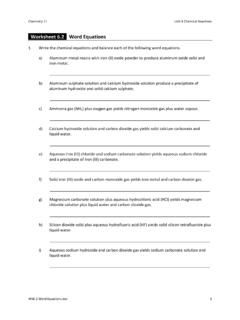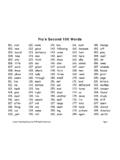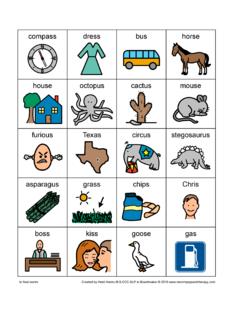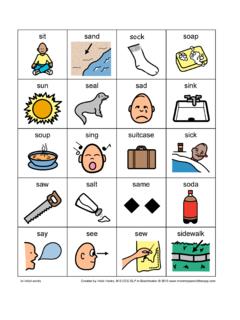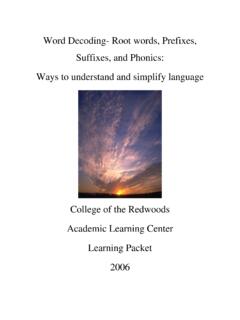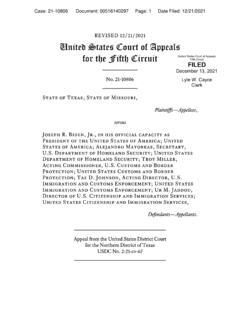Transcription of Tutor Handout Tips for Teaching Word Recognition
1 Tutor HandoutTips for Teaching Word RecognitionBackgroundBefore children can begin to read they need to understand the relationships between a symbol or a combination of symbols and the sound, or sounds, they represent. The ability to sound out or decode words is an important step in reading. When children correctly sound out a word, they are able to map it to their listening and speaking vocabulary. With a lot of practice, children begin to recognize many words automatically. The more words children recognize the easier it is for them to read. There will, however, always be unfamiliar words children must sound out. For this reason, decoding or sounding out words remains an important skill.
2 The understanding of sound/symbol relationships is complicated by the fact that some of the sounds in English are represented by more than one symbol or combination of symbols. For example the /f/ sound can be represented by the single consonant f as in fat, the consonant combination of ph as in phone, or gh as in laugh. There are many exceptions, especially when it comes to vowel sounds. For example the long e sound can be represented by e as in me, ee as in bee, ei as in receive, ie as in believe, ea as in leaf, and the e-consonant-silent e pattern as in Pete. Furthermore, some letters represent more than one sound, for example, the c in car and circus and ea in dead, bead, and steak.
3 These exceptions faced by beginning and struggling readers make learning to read all the more challenging. However, it is important to point out that 84% of the words in English have regular and consistent spelling patterns, and only 3% are highly are strategies readers can use to read unfamiliar words . When you work with children who are having difficulty reading words , you can use the following strategies to help them decode, pronounce, and understand unfamiliar words . First help students attack words piece by piece. Remember, it is best to guide and model rather than tell. It is always good to ask if the word makes sense or sounds right in the sentence. But do not let the child struggle too long.
4 If he or she cannot figure out a word after applying sound/symbol relationships and thinking about whether it makes sense, tell him or her the word and get on with Out the WordBeginning readers will know a limited number of sound/letter relationships, mainly beginning and ending sounds that they can apply to an unfamiliar word. As a Tutor , you will want to guide them as they attempt to decode unfamiliar wordso Start with the first letter or letters, in the case of diagraphs (ch, sh, ie, ea, etc.) and blends (st, bl, dr, etc). Have the child sound out the letter(s). As needed, have the child sound out the letter(s) at the end and in the middle of an unfamiliar word. For example, if the child correctly sounds out the beginning letter and still does not know the word, have him or her sound out the ending letter(s).
5 If a child has the beginning and ending sounds right but mispronounces the middle sound, point to or isolate the middle letters and ask him or her what sounds the letter(s) After sounding out the word, have the child blend the sounds together and try to say the word. Ask: Does the word make sense in the sentence? Learning A Z All rights HandoutTips for Teaching Word Recognition (continued)Use Picture Clueso Have the child look at the picture. This is a good strategy to confirm whether a word makes sense. For example, if they read cat instead of cow for the word cow, you can ask them to look at the picture and think about whether cat makes Ask: Are there people, objects, or actions in the picture that might make sense in the sentence?
6 O A child can use a combination of sounding out a word and using picture clues to confirm. The following sample dialog between Tutor and child uses banana as the unfamiliar word and demonstrates how to apply this : What letter does this word start with?C: bT: Yes, it starts with the letter b. What sound does the letter b stand for?C: No responseT: (after a 4-second wait) The letter b stands for the /b/ sound. Say the sound with me: /b/. Again: /b/. What word that starts with b would make sense here? Look at the picture for a clue. C: BananaT: That s right, banana. Good job. Now read the whole sentence for Word Chunks o Have the child look for familiar letter chunks within a word.
7 They may be sound/symbols, prefixes, suffixes, endings, whole words , or base words . Examples: and in sand, eat in Have a child read each chunk by itself. Then blend the chunks together and sound out the word. Ask: Does this word make sense in the sentence? o Help a child to recognize common endings (ing, ed, es, er, able, ness, tion, etc.), and common prefixes (un, re, in, dis, non, en, etc.)A sample Tutor and child dialog on chunking follows. The unknown word is dragging in the phrase dragging the jackal with him. T: This word looks hard, but I think you can sound it out. Can you find an ending part that you know on this word?C: ingT: What sound does the ing pattern stand for?
8 C: /ing/T: Yes, it stands for the /ing/ sound. Now cover the ing with your finger and see if you can sound out the rest of the word. Learning A Z All rights HandoutTips for Teaching Word Recognition (continued)C: : great. Now put that together with the ending : draggingT: Very good. Now read the phraseC: dragging the jackal with : Good job. Do you think the phrase makes sense?Apply Common Phonics RulesOlder readers can become familiar with certain phonics rules to help them decode. Since rules are not 100% reliable, a child should try the most common sound based on a rule first, and then check to see if the word sounded out makes sense. Common rules include:o If there is one vowel between two or more consonants, try the short vowel sound.
9 (Examples: fat, flat, shack. Exceptions: mind, gold)o If there are two vowels between two or more consonants, try the long vowel sound. (Examples: train, cheat, boat. Exceptions: bread, said, build)o If a one-syllable word ends with final e such as in cake, dive, and home, try the long vowel sound first. (Exceptions: have)o If a vowel is followed by the letter r, it doesn t have the long or short vowel sound. (Examples: bear, car, bird)Recognize Syllable PatternsOlder readers can learn to recognize syllable patterns in unfamiliar words . They can decode each syllable as if it were a single, smaller word then blend the syllables together. Often simply getting the first syllable will trigger the full can help children by helping them apply rules for dividing words into syllables.
10 These rules include:o If two consonants appear in the middle of a word try dividing the word between the two consonants, for example nap-kin; bas-ket. In these words (closed syllables), the vowel sound is often When only one consonant appears between two vowels, have the child try dividing the word before the consonant. This makes an open syllable, or one that ends in a vowel. Often open syllables have a long vowel sound. Examples: ti-ger; pa-per. This rule works about 55% of the time. If it does not work, have the child divide the word after the consonant. In this case the vowel will b short. Examples: nev-er; Prefixes and suffixes will form a syllable. In words ending with le such as simple and candle, the le plus the preceding consonant form one syllable.
